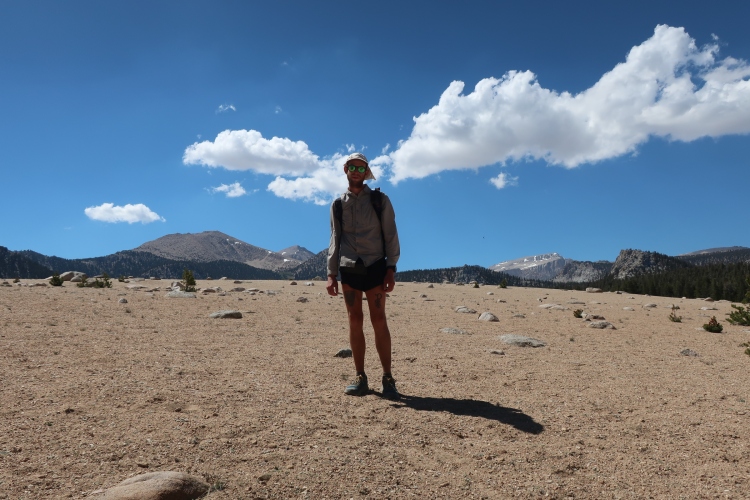
I practice the ultralight backpacking philosophy. Hiking comfort is most important to me, and I find that I don’t make sacrifices on sleeping comfort either. My kit is set up to encourage long days of hiking and little time in camp. I didn’t bring a stove, and reviewing photos at the end of the day was my entertainment. The trail provides the rest. For reference alongside gear sizes, I am 6′ tall. My base weight started around ~7lbs, and I ended at ~7.5lbs. I should just add my trekking pole to my base weight, because I rarely used the thing. So more like 8lbs is probably more accurate.
Shelter – MLD DCF .74 Grace Solo + Sil-Nylon Superlight Bivy (L)
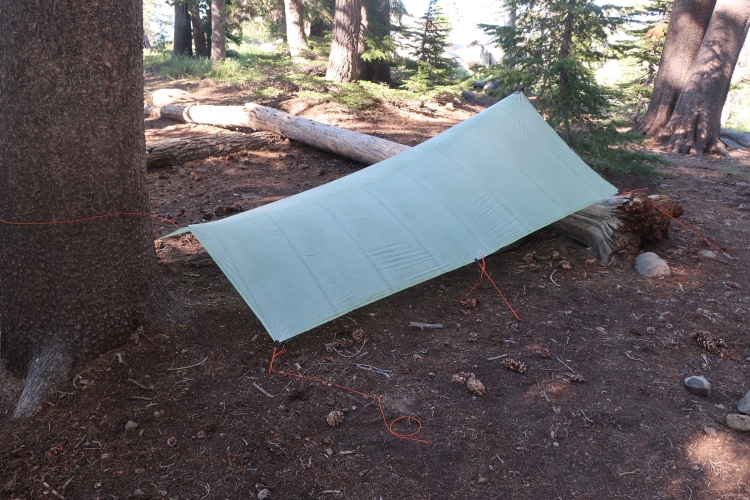
If I were to hike the PCT again, I would use this system. The only consideration I would have would be to switch to MLD’s Pro Poncho, not so that I could leave my rain jacket at home, though I probably would until Washington, but so that I could pin one end of my shelter to the ground during the windy nights in SoCal but retain the advantage of the tautness of a catenary cut tarp versus a flat one. I pitched my tarp around 10-12 times during my hike, and slept in my bivy the rest, even during the mosquito craze in the Sierra. I also added a polycryo ground sheet in Washington after my bivy began to tire. I removed the hardware from the tarp and used the knot method suggested by Andrew Skurka. I carried two trekking poles until Tuolumne Meadows, and carried one the rest of the way, using sticks or trees for one end of the tarp. I’ve stopped hiking with trekking poles, and next time I’d carry one lighter, carbon fiber pole for the shelter, and for navigating the occasional snow field or high stream.
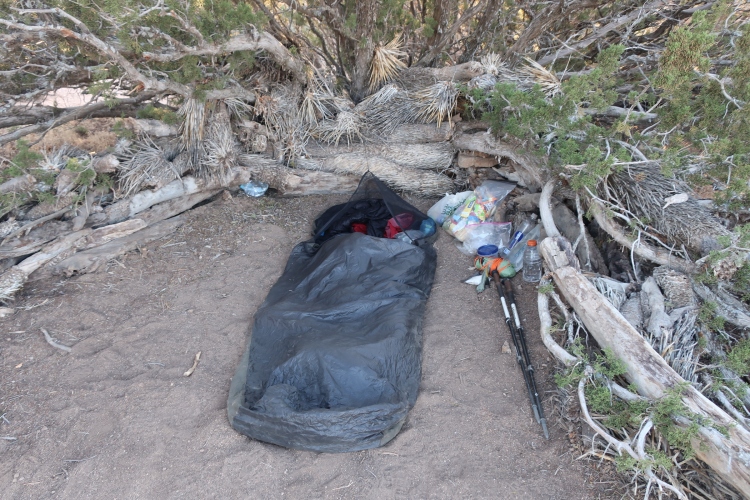
The bivy kept out the bugs, cut the wind, and provided ~5 degrees of warmth. I looked forward to zipping it up each night. To pull the netting off your face, you can tie it to a branch or other natural object above you, or, if you’re carrying a trekking pole, stick the pole into the ground just behind your head, and tie the cord around the pole handle. I chose the sil-nylon for its durability as a ground piece, and compactness over DCF. The weight sacrifice over DCF is marginal on this piece, not enough to convince me that DCF is the way to go here. Tarp + bivy total weight = 13.75 oz
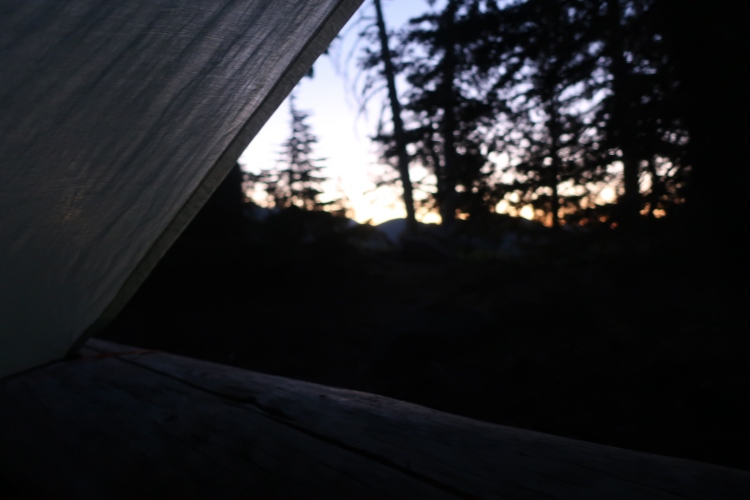
Sleep System – Katabatic Palisade 30 Degree Quilt + Thermarest Neo-Air (R)
My quilt may have been my favorite piece of gear. I’ve slept in a few different bags and one other quilt, and nothing compares to the comfort of this one. I am 6′ tall, and I use the 6’6′ version. It fits great. The warmth of the quilt plus my bivy and pad kept me toasty every night, too warm on many nights. I could have gotten by with a 40 degree, but that’s a little less versatile of a quilt off the PCT, and katabatic doesn’t offer one anyway. Enough’s been said about the sleeping pad. It’s the go-to air mattress for the weight/comfort value. I hiked until Lone Pine with the Gossamer Gear torso length Nightlight pad, and it was perfectly fine comfort wise, but it didn’t fit well in my pack. Actually, it was a pain to pack, and carried awkwardly. I left it in a hiker box because it wasn’t worth shipping home due to the large volume.
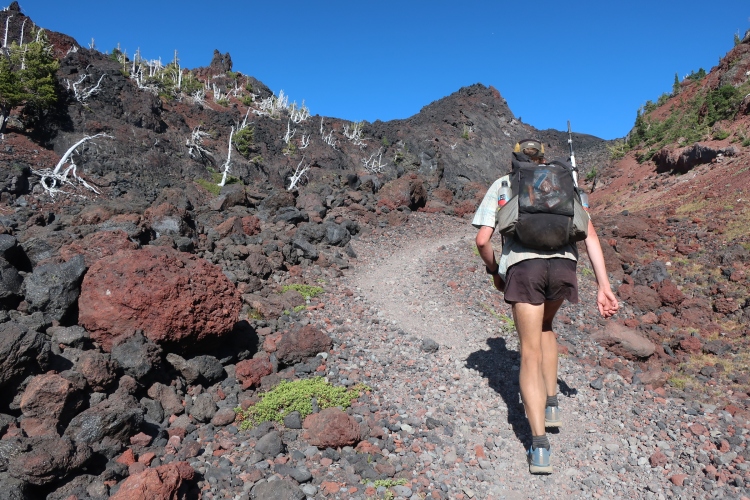
Pack – Pa’lante Simple
This one has a lot of hype I know, and I like the pack. I carried the first one until Cascade Locks, and switched to the V2. The Simple I started with wasn’t brand new, and the shoulder straps were digging into my shoulders by the end of Oregon. In general, my shoulders and back were hurtin’, bad, and I wanted the hipbelt option on the V2. So I got one and continued to enjoy the Pa’lante features. By the time I arrived to the Sierra with the Simple, food started falling out of the bottom pocket. To remedy it, I kept my bug head net at the end of the pocket to create a barrier. There was one instance where a bar fell out, and someone returned it to me up the trail. This hasn’t happened with the V2 version, with the rounded bottom and new sewing construction, and I’m confident it won’t be a problem later down the road. Functionally, this pack was great, and Pa’lante remedied all the issues I experienced with the first one with the updated version, except that it still doesn’t have drain holes in the side pockets, and it isn’t seam taped. I learned that it wasn’t seam taped when I went to sleep with a soaked sleeping pad in Washington, the only thing I didn’t have in my pack liner. This isn’t a huge deal out West, but it sucks in any rainy parts of the world. I thru hiked the Long Trail in Vermont with it after the PCT, and on days when it rained all day, I would periodically have to remove the pack and dump out the water from the side pockets.
Clothing
This one’s tough. I was content with the clothes that I brought, but it’s also what I’m least certain about bringing again.
Patagonia L/S and S/S Sun Stretch shirt –
I love these shirts. They were developed for fishing, and include a double layer of fabric (for wader abrasion resistance maybe?), where the shoulder straps of a backpack go, it’s long enough to tuck in my shorts at night if there is any breeze or chill, includes two zippered breast pockets, where I kept my aquamira, chapstick, and headphones, and it has a decent fit. It’s a combination of nylon and polyester. Nylon’s not the most breathable fabric, but it helps with durability and smell, and the fabric balance here seems perfect. I could have used the long sleeve for the entire hike, I think, as it was in perfect condition outside of light stains when I changed to a short sleeve at Sierra City.
Montbell Tachyon wind shell –
I never wore my layers all at once. Apart from base layer, I used my wind shell, the Montbell Tachyon, which is no longer made in the style I used, the most, every single day except some mornings in NorCal. It’s a quarter zip, mine’s yellow, and it rocked. It’s 2oz, and packs down small. There were lots of Melly’s on the trail, but you don’t need a fleece for most of the PCT.
Montbell Tachyon wind pants –
These are almost always too hot to hike in, and I mostly used them when caring for my feet at night before sleeping, and once on a night when I slept too close to a meadow in a valley floor. I hiked in them maybe 10 times. I would bring wind pants again, but I would prefer to have the Dynamo version, which have a zipper at the ankle. The weight penalty is .6oz. It’s worth it. The Tachyon’s can’t be removed without taking off your shoes. It’s inefficient, and it often dissuaded me from putting them on when I was cold. The Dynamo’s are also $20 cheaper.
Borah Down Jacket –
This is the lightest down jacket that I know of that isn’t a vest. You can get away without bringing a down jacket comfortably for most of the PCT, especially if you paired a fleece + a rain jacket like many hikers do, but most fleece garments alone weigh more than the wind shell/puffy combo I used, and less versatile. I’ll note here that when I got to Washington, I should have added a fleece (and waterproof gloves, and a rain skirt), because I got too cold hiking.
OR Research Helium II rain jacket –
I don’t know what to say about this one. It’s a little too short, but it’s light, and works well enough as any other DWR jacket. It was almost purely a pillow under my down jacket every night. I’ll probably go for an actually waterproof jacket next time at the cost of “breathability”.
Zpacks Fleece Hat, Liner Gloves, DT Socks –
Any fleece hat will do, just get yourself one. I used liner gloves only, some free ones I got with a road race package in NY, and they were sufficient for the trail. If they weren’t cutting it for the first half hour of hiking in the morning, I’d stick my hands in my shorts. I used Darn Tough’s thinnest running socks. They fit, and were comfortable, but they lasted about half as long as my shoes did, and my shoes didn’t last very long. I have a pile of them to return for their exchange program.
Shoes – Hoka One One Challenger ATR 4’s –
I experienced minor panic when Altra updated their Lone Peaks to 3.5’s, and they no longer fit me, so I tried Hoka. These fit me better than Altra, and I appreciated the heel drop (5mm). These are full mesh uppers. They’re lighter than Altras, have a similar stack height and cushion as the Lone Peaks’s, and are less sloppy. They would have been the perfect shoe for me with a pair of bio-soft insoles except the outsole is garbage. I could get ~275 comfortable (enough) miles in them, but then it became a waiting game until I made it to the next package that held my new shoes. The initial support felt like it blew out a substantial amount after even ~50 miles. This was a problem for me in the Sierra with the sections of talus going through and around snow fields over passes, so I tried the Speedgoats, which have a more firm Vibram tread. These felt better initially, but they proved to be too narrow for my feet, and caused me awful pain in my forefoot on both feet. Around mile 30 of each day, I could have cried. I wore them from Mammoth until Truckee, too far. I’ve had complaints about every shoe I’ve worn, and I’m now experimenting with Bedrock Sandals so that I’m relying on my feet rather than the shoe.
Aquamira water treatment
Repackage “A” and “B” into small dropper bottles, estimate how much you’ll use in a day in the morning while you’re still in your sleeping bag/quilt, and put that much in a pre-mix bottle. Get to a water source, fill up, drop some pre-mix in there, set your 15 minute timer on your watch, and get to hiking. The biggest advantage over membrane filters like the Sawyer squeeze is a lower failure rate, weight control, and time saved in places like southern California, when you’re treating 2-4 liters at a time. I treated my water for the entirety of the trail except when going over passes in the Sierra or collecting from glacial run-off, and some springs in Northern California.
Closing thoughts –
My gear choices are about how each piece of gear works with the other, how efficient, how light it is, and if I know how to use it to its capabilities, or if I’m ready to learn how. I don’t advise you transform your kit all at once, if you’re looking to make some changes. Change a piece of gear or two, learn how to use it by going backpacking with it in your area, and go from there. Jupiter (Hikes) makes a great point in his writing that hikers become skilled backpackers, or at least handy with their gear, by being weekend backpackers, because you get the chance to come home, evaluate your trip and your gear, and make changes. This isn’t as much of an option when on a long hike.
Gear Resources –
Mike Clelland’s Ultralight Backpackin’ Tips
Andrew Skurka’s Ultimate Hiker’s Gear Guide
Justin Lichter’s Trail Tested
Liz Thomas’s Long Trails: Mastering the Art of the Thru Hike
/r/Ultralight
Backpackinglight.com
www.katabaticgear.com
www.mountainlaureldesigns.com
www.palantepacks.com
www.montbell.us/
You were comfortable with the Palisade? No nights you wished you had the Alsek?
Not even one night. I slept in my hiking shirt and shorts every night except one, and then it was just a wind shell in the northern part of the Sierra when I ended up closer to a meadow than I wanted and got a little bit of katabatic air coming into camp. A few thinks to note here – I paired my quilt with a bivy, which bumps the temp up ~5 degrees, and I was meticulous about where I slept, warmth wise. Also, I understand that it’s common for women to run slightly cooler.
If not going with a bivy, and you want more versatility out of a quilt for other trails, go for the Alsek.
Notes taken, thanks! I’m actually a warm sleeper and usually cowboy camp or tent and the Alsek has been the one I’ve been looking at, I just keep talking myself in and out of it since I haven’t seen one or know anyone with one. It’s stressful buying gear blind.
The quilts in Katabatic’s elite series are beautiful, clean quilts. I saw a few on the trail, and know a guy who hiked the trail last year during the same time frame as me using the Alsek with no issue. I’ve also heard from a few people who bought the Palisade who wished that they would have gotten the Alsek.